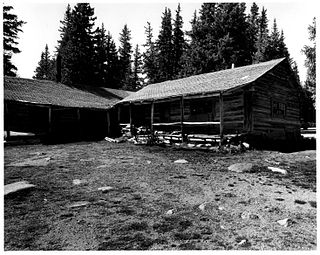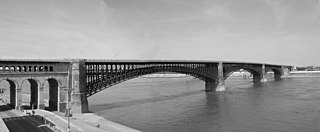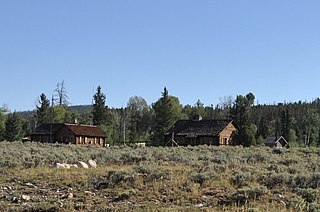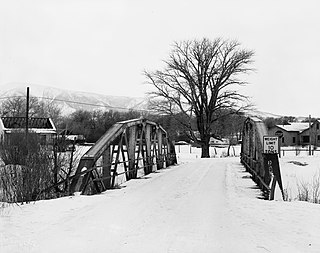The Squirrel Meadow Guard Station is a ranger station in the backcountry of Targhee National Forest in Wyoming. The original facility was established in 1907, with the present structures built in 1934. The log cabin station is an example of a standard US Forest Service backcountry patrol structure.

The Brooklyn Lodge or Brooklyn Lake Lodge was built in 1922–23 for former rodeo performer Harry "Hoot" Jones. The log lodge, located near Centennial, Wyoming in the Snowy Range of Medicine Bow National Forest, was operated by the Jones family until the late 1930s.

The Snowy Range Lodge, formerly known as the Libby Lodge, is located in the Snowy Range of Medicine Bow National Forest in Wyoming. The three-story log lodge was built in 1925 as the Libby Lodge. From 1925 to the mid-1970s, the Lodge served as a classic mountain lodge, sleeping up to 75 people in the main lodge and in ten cabins on 40 acres leased from the US Forest Service. In the mid-1970s, it fell into a state of abandonment, neglect, and disrepair such that the Forest Service planned to burn and bulldoze it as it presented a liability risk to National Forest users who might venture inside.

This is a list of the National Register of Historic Places listings in Big Horn County, Wyoming.

The Virginian Hotel is a historic hotel in Medicine Bow, Wyoming, United States. Construction on the hotel began in 1901 and was completed in 1911. It was built by August Grimm, the first mayor of Medicine Bow, and his partner George Plummer. The hotel is thought to be named for the famous novel written in Medicine Bow, The Virginian by Owen Wister. Although it provided a place for cowboys and railroad workers to stay while they were in town, the hotel was actually built to serve a much broader clientele. It became a headquarters for all to meet and eat as well as a setting for many business dealings.

The Keystone Bridge Company, founded in 1865 by Andrew Carnegie, was an American bridge building company. It was one of the 28 companies absorbed into the American Bridge Company in 1900. The company advertised its services for building steel, wrought iron, wooden railway and road bridges. It held a patent for wrought iron bridges and also supplied wrought iron columns for buildings. Thomas Carnegie worked for Keystone Bridge as treasurer for roughly 20 years, from the founding of the company until his death in 1886.
Architects of the United States Forest Service are credited with the design of many buildings and other structures in National Forests. Some of these are listed on the National Register of Historic Places due to the significance of their architecture. A number of these architectural works are attributed to architectural groups within the Forest Service rather than to any individual architect. Architecture groups or sections were formed within engineering divisions of many of the regional offices of the Forest Service and developed regional styles.

The Brush Creek Work Center in Medicine Bow National Forest near Saratoga, Wyoming is a ranger station of the USDA Forest Service, Region 2 that was built during 1937-41 and is listed on the National Register of Historic Places. It was designed by architects of the United States Forest Service in rustic style. The designs were applications of standard plans.

The Centennial Work Center in Medicine Bow National Forest near Centennial, Wyoming was built in 1938. It was built to replace the nearby Centennial Ranger Station. It was designed by USDA Forest Service, Region 2 in USFS rustic architecture and served as a government office. It was listed on the National Register of Historic Places for its architecture. The listing included three contributing buildings, a bunkhouse, a combined office and bunkhouse, and a garage, on 5 acres (2.0 ha).
La Prele Work Center is a work center located in Medicine Bow National Forest near Douglas, Wyoming. The building was constructed from 1937 to 1941 by the Civilian Conservation Corps. The log building was designed by U.S. Forest Service architects in a rustic style distinct to the USFS. The building originally served as a ranger station for the La Prele Ranger District and was called the Cold Springs Ranger Station. In 1941, the station was renamed the La Prele Ranger Station. The building served as a ranger station until the La Prele district was consolidated in 1956; it is now a work center for U.S. Forest Service work crews.
Frederic Hutchinson "Bunk" Porter, Sr., sometimes referred to as Frederick Hutchinson Porter, was an American architect based in Cheyenne, Wyoming. He was active from 1911 to approximately 1965. He designed many of Cheyenne's most important public and commercial buildings and also designed several buildings at the University of Wyoming, including War Memorial Stadium and the Agriculture Building. A number of his works are listed on the U.S. National Register of Historic Places.
Architects of the National Park Service are the architects and landscape architects who were employed by the National Park Service (NPS) starting in 1918 to design buildings, structures, roads, trails and other features in the United States National Parks. Many of their works are listed on the National Register of Historic Places, and a number have also been designated as National Historic Landmarks.

The DFU Elk Mountain Bridge was a Warren pony truss bridge located near Elk Mountain, Wyoming, which carried Carbon County Road 120-1 over the Medicine Bow River. The bridge was built in 1823 by contractor D. B. Miller. While the bridge's design is mainly a Warren truss, the top chord of the bridge is reminiscent of a Parker truss. At 102 feet (31 m) long, the bridge is the longest of its design in the Wyoming county highway system.
Carbon is a ghost town in Carbon County, Wyoming, United States. It is 9.5 miles (15.3 km) west-southwest of Medicine Bow. The Carbon Cemetery, which is listed on the National Register of Historic Places, is located in Carbon.

The Wilton Public and Gregg Free Library is the public library of Wilton, New Hampshire. It is located in a Classical Revival brick building on Forest Street, near the north end of Wilton's downtown area. The building was designed by the Boston, Massachusetts, firm of McLean & Wright, and built 1905-07. It was a gift of David Almus Gregg, a local manufacturer of building parts; Gregg further gave the library an endowment in 1912. It was listed on the National Register of Historic Places in 1982.

Libby's No. 23 is a historic sail-powered fishing vessel, now on display at the Lake Clark National Park and Preserve visitors center in Port Alsworth, Alaska. Built in 1914, she served in the salmon fishery of Bristol Bay until about 1951, owned by the Libby's cannery and worked by two-man crews. She is 29 feet 6 inches (8.99 m) long, with a beam of 9 feet 2 inches (2.79 m) and a depth of 4 feet (1.2 m). Its bow and stern are roughly the same shape, giving the style its name. Despite its use for freight and recreation between 1953 and 1997, the boat has retained much of its original equipment, and was fully restored by the National Park Service between 1998 and 2005, acquiring replacement parts from similar boats and removing an added motor. It is normally rigged with a mainsail and spritsail, but these are only raised when the boat is taken out of its custom-built boathouse.
The Jack Creek Guard Station is a ranger patrol cabin in Medicine Bow National Forest in Carbon County, Wyoming. The one-room log cabin was built by U.S. Forest Service district ranger Evan John Williams in 1933-34. It was built to Forest Service Plan A-4, featuring half-dovetailed corners and a deep front porch with a gabled wood shake roof. A stove is vented through a brick chimney at the back of the cabin.

The Medicine Bow Union Pacific Depot was built 1912–1919 in Medicine Bow, Wyoming for the Union Pacific Railway. It is a typical example of Union Pacific railway architecture with a hipped clay shingle roof with broad overhangs supported by brackets over a one-story wood-frame station structure. The depot features a projecting bay designed to allow the station master to see incoming trains. The western section of the building contained the waiting room, the station office and a baggage room, while the eastern section contained living quarters for the stationmaster and his family. The station functioned in its original purpose until May 1981.

Site 32 SL-O Intermediate Field Historic District, also known as the Medicine Bow Airport, is an early lighted airway on the Transcontinental Airway System, located just south of the town of Medicine Bow, Wyoming. The airport was built one mile west, then moved to this location in 1929, as an emergency landing field on Route T, the New York to San Francisco airway, between larger airfields at Salt Lake and Omaha. It included a constantly-lit beacon and a cement arrow which pointed the way to the next beacon along the airway route.
Union Pacific Depot or variations such as Union Pacific Station or Union Pacific Railroad Depot may refer to:













